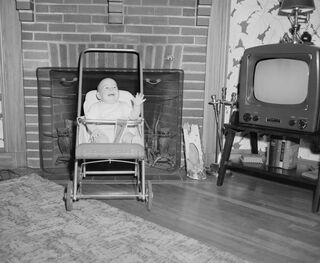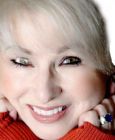Memory
Are You a Boomer Shaped By 1950s TV?
TV convinced us that every family functioned, and all children were loved.
Posted June 10, 2021 Reviewed by Davia Sills
Key points
- It’s no surprise that kids claimed TV as their own and that TV singled them out as a key demographic.
- The ideals it portrayed back in the 1950s made us all think that was how people lived behind closed doors.
- Perhaps it’s time to embrace how some of those long-term, seemingly trivial recollections shaped you.

If long-term memory sharpens as you age, and the short-term details are what you forget in the blink of an eye (befuddling and embarrassing you), perhaps it’s time to embrace how some of those long-term, seemingly trivial recollections shaped you.
In his 2016 article, "Growing up together, TV and baby boomers were a perfect fit," Associated Press columnist Frazier Moore documents how TV was key to the world into which baby boomers were born. Our booming, post-war, modernized world made it appear that every solution was around the corner—from a cure for polio to a man going into space to atomic energy to civil rights. Computers were introduced in some spheres in 1951: “TV chronicled this bracing wave of wonder and potential and built upon it as an essential part of what sets boomers apart. They were pampered and privileged and groomed for a sure-to-be glorious tomorrow.” He goes on to say that, because of all this, it’s no surprise that kids claimed TV as their own and that TV singled them out as a key demographic.
Growing up with TV in the '50s
Those of us born in the ‘50s and slightly later may have been intensely affected by what they watched on TV as a kid—when there were only three network channels. As we heard the sounds of xylophone tones being played as the NBC peacock spread its feathers, we situated ourselves in front of the screen at the same time for the same shows each day or each week. My earliest recollections were kids’ shows, of course. A woman dressed up as a lady sheepherder, Howdy Doody time, some locals hosting cartoons, and of course, Mr. Wizard.
None, however, affected me like The Mickey Mouse Club. My BFF and I would rush home from school, our moms would arm us with snacks, and we would sit cross-legged about 12 inches away from a massive box filled with tubes and a curved screen. Mom would adjust the rabbit ears, and we were good to go. Each day of the week was a different theme—there was “Fun With Music Day”; “Guest Star Day”; “Anything Can Happen Day”; “Circus Day”; and “Talent Roundup Day.” Okay, I looked those up. My memory isn’t that great.
In case you are unfamiliar with this show, it consisted of a group of children aged from around 8-14 or so. Each episode was filled with some music, some dancing, usually a short “serial,” and at the end, a slow song saying farewell when we waved at the TV screen as if those kids could see us. As the show began, the “Mouseketeers” introduced themselves individually, their names emblazoned across their short-sleeved turtlenecks (which had me gravitating toward turtlenecks the rest of my life), and the girls wore flouncy accordion-pleated skirts.
Annette Funicello was by far my favorite role model—petite, dark-haired, and sparkly-eyed. And Friday—Talent Roundup Day—was my favorite day of the week because these amazing kids were dancers, singers, baton twirlers, and guitar players. What did it all teach me? Well, for one, I learned to my dismay that we couldn’t jump inside the TV console and become one of them. And secondly, I had no idea these kids were all carefully auditioned talent. I was positive any one of us could get up on that TV stage and do what they did.
Lesson 1 — Anything was possible.
The show’s serial features often took on a life of their own. One of them, Spin and Marty, centered around boys at a ranch camp, and each had his own horse assigned. While the whole Western thing—cowboy hats and roping—held no interest for me, the show got me hooked on the beauty and majesty of equines for the rest of my life. Of course, living in San Francisco offered me no chance to ride a horse.
But when we moved 100 miles away to suburban Sacramento, and I found out our (much wealthier) next-door neighbors gave their daughter horseback riding lessons, I literally begged my parents for them. They dismissed the idea as useless to my future as well as unaffordable. Piano lessons? Always on the agenda. Later on in adult life, however, I paid for my own horseback riding lessons and loved every second of them. I still love to ride whenever I can.
Lesson 2 — The universe doesn't always deny. It just delays.
Of course, there were adult shows we watched with our parents (back when families watched TV together), carefully chosen from the newspaper or TV Guide lineup. The Westerns. The shows that illustrated perfect (and fun) family life. And one night a week, Jackie Gleason appeared in The Honeymooners. I remember it being on Saturdays since that was “bath night” for us, and we were permitted to stay up a bit later.
Gleason played a volatile bus driver (Ralph Kramden) who yelled often and loudly at his wife, Alice. She yelled back in a nasal, whiny voice, but most often, she just put up with him, laughing him off. Yet the show depicted them as loving one another, with Ralph saying a very occasional affectionate line to Alice.
I could never figure out why they or their neighbors had no kids and why they continued to live in a drab apartment in New York. All I knew is that Alice put up with a lot from him and stayed through it all. I would go on in my own life to see my father bluster at my mother (also named Alice). Then I went on to marry a man who also blustered, thinking he was harmless at first but found out otherwise. I finally realized I didn’t have to stay like Alice did. I had options.
Lesson 3 — Everyone deserves respect. Abuse in any form is not a form of love.
My father, especially, was riveted to the TV screen for the dinner hour news, and we all had to shut up while we ate. You had, as I said, a choice of three news anchors (or pairs of anchors) to choose from, and all three tended to report the same things. Big news only. You pretty much knew what was happening around the world as it affected the U.S.
Local news was also much more sober. There were no talking heads, no “entertainment news,” no laughs, no stories about celebrity scandals (those were reserved for tabloids we saw in the grocery store at the checkout stands), and nothing laced with opinions reflecting the newscasters’ politics. Sponsors had little influence over what was presented, and the Fairness Doctrine was intact, which meant they had to report both sides of each controversial piece of news. It was up to the viewer to choose the anchor they liked best and form their own opinions based on the facts of the day.
Lesson 4 — Opinions are rampant. Don’t take something for the gospel truth just because it serves your own worldview. Look for the facts, study both sides and use your own brain to form opinions about it.
In his article, Moore concludes that these days, the TV experience isn’t nearly as much about viewing as it is immersion. “It doesn’t just bring the world to the audience, it is the world,” he says, noting how it continues to merge with other screened devices, further expanding its presence. The ideals it portrayed back in the 1950s, however, made us all think that was how people lived behind closed doors. That every family functioned. All children were loved. That there is a moral and lesson hidden in every day. And going back to my first lesson: anything was possible. I think I’m glad to have grown up in that hopeful fantasy.




